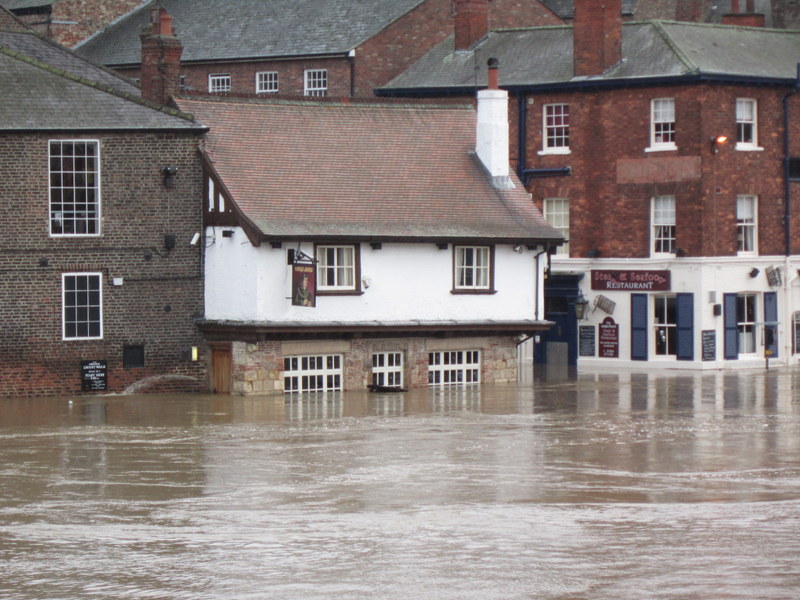Clients get a 'no' as banks start using new reports

The King’s Arms pub in York was founded in the 1700s, when the dead bodies of executed criminals would be laid out on the floor before being displayed on nearby Lendal Bridge as a gory deterrent. Ever since then, several times a year, patrons have had to suffer regular flooding from the river Ouse, just metres from the front door.
At one time, patrons would wade through flood waters to get served, now, unfortunately, the fun police have outlawed that damp novelty (and also the decoration of nearby Lendal Bridge with corpses).
But as the weather gets regularly warmer in the UK, so too is the amount of rain the country gets – the last 18 months have been the wettest since records began in 1836. As well as more built-up areas for water to run off, warmer air can carry more water to drop as rain – and so the genuine old-time King’s Arms experience is coming to many more homeowners’ living rooms – and mortgage lenders are taking notice.
Homeowners living in areas prone to flooding are being informed that their properties are at risk and will no longer qualify for new mortgage deals, despite some of these homes never having experienced a flood. This development comes as the Bank of England warns that increasingly wet weather could lead to homes becoming uninsurable, potentially lowering property values. The Bank has already identified lenders’ mortgage portfolios being at particular risk, given that a house that becomes uninsurable will lose value – perhaps substantially.
Since another 2021 Bank of England report advising financial institutions to address climate change risks, lenders have been utilizing mapping technologies to assess which homes are most at risk.
“UK mortgage impairments are concentrated in areas predicted to be most heavily impacted by flooding, with nearly half of all projected mortgage losses arising from just one tenth of postcode districts” said the report. “The areas banks identified as likely to be responsible for the greatest credit losses in the NAA scenario were broadly similar, but not identical to those identified by insurers as most likely to flood.”
And this week, Tracey Garrett, CEO of the advice charity National Flood Forum, told The Times she has been contacted by a number of households who were unable to secure a new mortgage deal at the end of their fixed-rate term, though they previously encountered no issues. "We hardly heard of this happening before," she said.

The King’s Arms, York – regularly flooded since 1795. It has no flood insurance and is flooded four times a year on average.
© Copyright Ian S and licensed for reuse under this Creative Commons Licence.
Another source told the paper that they knew directly of Nationwide and Halifax declining to offer new deals. "Someone told me, ‘I’ve just lost the sale of my house because no buyer can get a mortgage due to flood risk.’ She was absolutely devastated," she said.
“Only last week, I was made aware of homeowners being hit with mortgage rate hikes when renewing, due to the perceived flood risk of their home. In one case, the lowest rate they could find was 10.5% (compared to a previous rate of 4.7%),” said Mary Long-Dhonau OBE who calls herself a ‘property flood resilience champion.’ “And, now we are seeing lenders opting to move away from some vulnerable properties. If this trend persists, mortgages for those at flood risk could become unaffordable, stifling homeownership opportunities and further exacerbating inequality.”
Although there is a national flood reinsurance scheme, Flood Re, its profits have been decimated, and insurers seem to be keen to withdraw from the system when it expires in 15 years.
The rising costs of weather-related damage are a contributing factor, with claims reaching £573 million last year – and there are concerns that homeowners are keeping quiet about minor flood damage fearing it might negatively impact their property values.
Fast flood facts:
- Around 5 million people live in flood risk areas in England and Wales.
- One in six homes in England is at risk of flooding.
- 25% of flooding occurs outside areas formally designated as being flood prone.
- 8% of new homes have been built in flood zones according to insurer Aviva
- Homes built after 2008 are not eligible to use FloodRe
In July, the Bank of England cautioned that wetter winters could lead to more homes being flooded, rendering them both unmortgageable and uninsurable, which could ultimately affect their market value. "An increased actual or perceived risk of flooding could influence property prices through expectations of higher insurance costs or the withdrawal of coverage," the Bank stated. It added that such changes could increase the potential losses for residential mortgages, particularly in high-risk flood areas.
One of the problems facing mortgage clients is that there at least four different flood mapping techniques, which results in inconsistent outcomes for homeowners. Banks generally don’t disclose the specifics of the mapping systems used but Nationwide has already announced that it won’t offer mortgages on properties that it considers to be high flood risk.
“The company will decline to make a loan to purchase some properties it deems to be at high risk,” Rob Stevens, head of property risk at Nationwide said in May this year. “If we’re doing a 40-year mortgage term, and there’s something there that I know could fundamentally change for the customer, I can’t not know that.”
Six of the UK’s top 10 lenders use a solution from Hometrack/Twinn - Leeds Building Society, Yorkshire Building Society and HSBC were the first to sign up for the offering. A large number of new homes have already been built in areas susceptible to flooding - “It’s concerning that almost 110,000 new homes have been built in the last decade in a flood zone, leaving thousands of homeowners and tenants at risk,” said Aviva’s CEO. “Crucially, these homes are not covered by the Flood Re insurance scheme and many may have been constructed without flood resilience. Not only are these newly-built homes at high risk, they also face the prospect of repeated flooding and may not be protected by flood defences to prevent or limit flood damage.
Which areas are most at risk from climate -related flooding?
According to Insurance Business;
- Cardiff, Wales – 17.09% of properties at risk, up from 15.06% in 2020
- Windsor and Maidenhead, England – 16.18%, up from 14.61%
- Warrington, England – 14.36%, up from 13.28%
- Barking and Dagenham, London, England – 12.31%, up from 11.56%
- Neath Port Talbot, Wales – 12.20%, up from 7.88%
- Scottish Borders, Scotland – 10.57%, up from 9.24%
- Rhondda Cynon Taf, Wales – 9.31%, up from 7.95%
- West Berkshire, England – 9.02%, up from 8.20%
- Greenwich, London, England – 8.92%, up from 8.52%
- Clackmannanshire, Scotland – 8.72%, up from 7.45%
If you want to read the latest report on the climate in the UK from the Royal Meteorology Society, you can find all glorious 121 pages here.
Or, we’ve saved you some of the bother with this executive summary (but no charts, we’re afraid).
Increased Flood Risk: The UK is experiencing more frequent and intense rainfall, increasing the risk of flooding in many areas.
Impact on Property Values: Homes in flood-prone areas are becoming harder to insure, which could lead to significant drops in property values.
Mortgage Eligibility: Many lenders are using advanced mapping technologies to assess flood risks, which has already resulted in some properties being deemed ineligible for new mortgage deals.
Climate Change and Lender Responsibility: The Bank of England is urging lenders to factor climate risks into mortgage decisions, as future climate events may increase defaults and losses.
End of Flood Re Scheme: The Flood Re insurance scheme, designed to protect flood-risk homes, is set to end in 2039. Its conclusion could leave many properties uninsured and lead to further devaluation.
Market Implications: Without proper flood insurance, properties may become unmortgageable, creating risks for homeowners and financial institutions.
Need for Long-Term Solutions: Experts are calling for continued or extended insurance solutions, such as a potential "Flood Re 2," to safeguard both homeowners and the mortgage industry from the rising risks of climate change.



